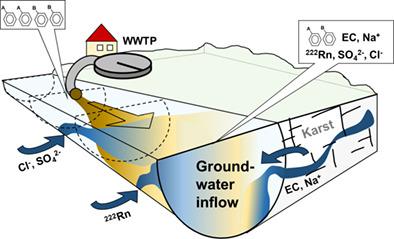当前位置:
X-MOL 学术
›
Hydrol. Process.
›
论文详情
Our official English website, www.x-mol.net, welcomes your
feedback! (Note: you will need to create a separate account there.)
Comparison of environmental tracers including organic micropollutants as groundwater exfiltration indicators into a small river of a karstic catchment
Hydrological Processes ( IF 2.8 ) Pub Date : 2020-09-14 , DOI: 10.1002/hyp.13909 Clarissa Glaser 1 , Marc Schwientek 1 , Tobias Junginger 2 , Benjamin Silas Gilfedder 3 , Sven Frei 4 , Martina Werneburg 1 , Christian Zwiener 1 , Christiane Zarfl 1
Hydrological Processes ( IF 2.8 ) Pub Date : 2020-09-14 , DOI: 10.1002/hyp.13909 Clarissa Glaser 1 , Marc Schwientek 1 , Tobias Junginger 2 , Benjamin Silas Gilfedder 3 , Sven Frei 4 , Martina Werneburg 1 , Christian Zwiener 1 , Christiane Zarfl 1
Affiliation

|
Understanding groundwater–surface water (GW–SW) interactions is vital for water management in karstic catchments due to its impact on water quality. The objective of this study was to evaluate and compare the applicability of seven environmental tracers to quantify and localize groundwater exfiltration into a small, human‐impacted karstic river system. Tracers were selected based on their emission source to the surface water either as (a) dissolved, predominantly geogenic compounds (radon‐222, sulphate and electrical conductivity) or (b) anthropogenic compounds (predominantly) originating from wastewater treatment plant (WWTP) effluents (carbamazepine, tramadol, sodium, chloride). Two contrasting sampling approaches were compared (a) assuming steady‐state flow conditions and (b) considering the travel time of the water parcels (Lagrangian sampling) through the catchment to account for diurnal changes in inflow from the WWTP. Spatial variability of the concentrations of all tracers indicated sections of preferential groundwater inflow. Lagrangian sampling techniques seem highly relevant for capturing dynamic concentration patterns of WWTP‐derived compounds. Quantification of GW inflow with the finite element model FINIFLUX, based on observed in‐stream Rn activities led to plausible fluxes along the investigated river reaches (0.265 m3 s−1), while observations of other natural or anthropogenic environmental tracers produced less plausible water fluxes. Important point sources of groundwater exfiltration can be ascribed to locations where the river crosses geological fault lines. This indicates that commonly applied concepts describing groundwater–surface water interactions assuming diffuse flow in porous media are difficult to transfer to karstic river systems whereas concepts from fractured aquifers may be more applicable. In general, this study helps selecting the best suited hydrological tracer for GW exfiltration and leads to a better understanding of processes controlling groundwater inflow into karstic river systems.
中文翻译:

比较环境示踪剂,包括有机微量污染物作为地下水渗入指标,进入岩溶流域的一条小河
由于岩溶对水质的影响,因此了解地下水与地表水(GW-SW)的相互作用对于岩溶流域的水管理至关重要。这项研究的目的是评估和比较七种环境示踪剂在量化和定位地下水到人为影响的小型喀斯特河系中的适用性。根据示踪剂对地表水的排放源来选择示踪剂,其形式为(a)溶解的,主要为地源的化合物(rad222,硫酸盐和电导率)或(b)源自废水处理厂(WWTP)废水的人为化合物。 (卡马西平,曲马多,钠,氯)。比较了两种截然不同的采样方法(a)假设为稳态流动条件,(b)考虑水小包通过集水区的旅行时间(拉格朗日采样),以说明污水处理厂的入水量的日变化。所有示踪剂浓度的空间变异性表明优先流入地下水的区域。拉格朗日采样技术似乎与捕获WWTP衍生化合物的动态浓度模式非常相关。基于观测到的河内Rn活动,使用有限元模型FINIFLUX量化了GW流入,导致沿调查河段(0.265 m 拉格朗日采样技术似乎与捕获WWTP衍生化合物的动态浓度模式非常相关。基于观测到的河内Rn活动,使用有限元模型FINIFLUX对GW流入进行量化,导致沿调查河段(0.265 m 拉格朗日采样技术似乎与捕获WWTP衍生化合物的动态浓度模式非常相关。基于观测到的河内Rn活动,使用有限元模型FINIFLUX对GW流入进行量化,导致沿调查河段(0.265 m3 s -1),而对其他自然或人为环境示踪剂的观测则产生的水通量较少。地下水渗漏的重要来源可归因于河流穿越地质断层线的位置。这表明,假设多孔介质中存在扩散流的情况下,描述地下水与地表水相互作用的常用概念很难转移到岩溶河流系统中,而裂缝性含水层的概念可能更适用。总的来说,这项研究有助于选择最适合GW渗透的水文示踪剂,并有助于更好地理解控制地下水流入岩溶河流系统的过程。
更新日期:2020-11-09
中文翻译:

比较环境示踪剂,包括有机微量污染物作为地下水渗入指标,进入岩溶流域的一条小河
由于岩溶对水质的影响,因此了解地下水与地表水(GW-SW)的相互作用对于岩溶流域的水管理至关重要。这项研究的目的是评估和比较七种环境示踪剂在量化和定位地下水到人为影响的小型喀斯特河系中的适用性。根据示踪剂对地表水的排放源来选择示踪剂,其形式为(a)溶解的,主要为地源的化合物(rad222,硫酸盐和电导率)或(b)源自废水处理厂(WWTP)废水的人为化合物。 (卡马西平,曲马多,钠,氯)。比较了两种截然不同的采样方法(a)假设为稳态流动条件,(b)考虑水小包通过集水区的旅行时间(拉格朗日采样),以说明污水处理厂的入水量的日变化。所有示踪剂浓度的空间变异性表明优先流入地下水的区域。拉格朗日采样技术似乎与捕获WWTP衍生化合物的动态浓度模式非常相关。基于观测到的河内Rn活动,使用有限元模型FINIFLUX量化了GW流入,导致沿调查河段(0.265 m 拉格朗日采样技术似乎与捕获WWTP衍生化合物的动态浓度模式非常相关。基于观测到的河内Rn活动,使用有限元模型FINIFLUX对GW流入进行量化,导致沿调查河段(0.265 m 拉格朗日采样技术似乎与捕获WWTP衍生化合物的动态浓度模式非常相关。基于观测到的河内Rn活动,使用有限元模型FINIFLUX对GW流入进行量化,导致沿调查河段(0.265 m3 s -1),而对其他自然或人为环境示踪剂的观测则产生的水通量较少。地下水渗漏的重要来源可归因于河流穿越地质断层线的位置。这表明,假设多孔介质中存在扩散流的情况下,描述地下水与地表水相互作用的常用概念很难转移到岩溶河流系统中,而裂缝性含水层的概念可能更适用。总的来说,这项研究有助于选择最适合GW渗透的水文示踪剂,并有助于更好地理解控制地下水流入岩溶河流系统的过程。











































 京公网安备 11010802027423号
京公网安备 11010802027423号